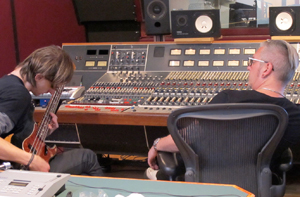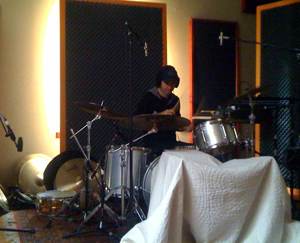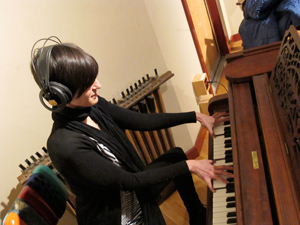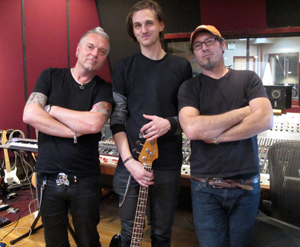Mission Sound Welcomes Dead Leaf Echo and a Cult Music Production Hero from the U.K.
WILLIAMSBURG, BROOKLYN: In the past few months, Mission Sound has hosted current buzz-generators Matt and Kim, Arctic Monkeys and Animal Collective, as well as perennial punk-rock veterans Bad Religion. This month, Oliver Straus’ Williamsburg studio welcomes Brooklyn shoegazers Dead Leaf Echo and UK-born producer John Fryer. We stopped by to talk shop and got an earful.
Before helping Industrial artists like Nine Inch Nails create raw and powerful new sounds in the 90s, Fryer established himself as a capable, smart-mouthed young engineer at London’s Blackwing Studios. It was there that he would team up with seminal artists Cocteau Twins and Depeche Mode to invent unique and influential new textures for 4AD and Mute Records as early as 1981.
Fryer is a natural choice for Dead Leaf Echo, who spend their days imagining up wide expanses of ethereal guitars anchored by tight, driving rhythms. These stark, yet deeply textured soundscapes create a foundation for songs that Textura describes as “four-minute cathedrals of dreampop splendour”.
If there’s anyone who knows about developing these kinds of expansive textures, it’s Fryer, who is unafraid of using technology to make a sonic statement. “It’s all about warping sounds,” he says, “Bastardizing them.”
Fryer’s early home-base, Blackwing, was built out of a deconsecrated church that lost much of its original vaulted ceilings to new construction. This environment, coupled with an experimental nature, led Fryer and his contemporaries to rely heavily on early AMS reverbs, delays and Eventide Harmonizers to add lush, hyper-real colors to the sonic palette.
As the analog and digital eras merged, technology also began to play a greater role in sound generation at Blackwing. Fryer was behind the board when art-punk trailblazers Wire shifted gears for It’s Beginning to and Back Again. He told us about their use of early Akai samplers: “With Graham (Lewis) and Bruce (Gilbert), it was about manipulating sounds. If anything made a sound, it was an instrument. Plug an object straight into the sampler and there you go. Detune it, whatever, and you have a new voice.”
He was also present just when computers started to become central in the studio. “In England we were using the Ataris. Then Trent (Reznor) comes into the studio with his Mac” he says, referring to an early Macintosh Plus used to sequence rhythmic tracks on the Pretty Hate Machine sessions. “It was the first time I had seen a Mac in the studio, and now here we are, working on one today!”
At this point, Oliver Straus, (Mission Sound’s Owner/Engineer) looked up from a quick drum edit on a widescreen display 10 times larger than the monochrome 9-inch screen of the original Macintosh Plus. Oliver’s skills here are one of the reasons Dead Leaf Echo chose Mission Sound: Straus knows drums.
Fryer and Straus worked together to tweak live sounds throughout. At times, they steered toward tight drum-machine-like beats, and on other occasions, swapped drummer J. Parker’s normal crash cymbals for washy, heavy rides that would pair with well-nuked room mics to create a slowly swirling sheen with exaggerated decay.
Sounds like these add depth to Dead Leaf Echo’s atmospheric fabric, which is often woven more out of mood than of melody. It’s a shimmering backdrop that spotlights singer LG’s wandering, gossamer vocals and has earned them regular opening slots for textural mavericks Chapterhouse, Ulrich Schnauss, and A Place to Bury Strangers. Today, these Brooklyn locals are recording their first full-length after a series of well-received EPs the band released in small, handmade batches over the past two years.
Like 4AD founder Ivo Watts-Russel, DLE’s current collaborator wasn’t trained as a musician, and speaks pictorially about sound. Still, John Fryer is able to give pointers about song structure and musical phrasing: “Since I don’t play, music comes down to a feeling, and I do whatever I can to enhance the mood of the music,” Fryer says.
He sees this perspective as a unique asset that even helps avoid ego battles in the studio: “Even if the musician can’t play worth a damn, they can still play better than me!” He also suggests his background keeps each artist’s musical vision pure. “I’m not a failed musician, you know? I’m there to make the band’s record, not mine. ”
Ironically enough, this veteran producer and “non-musician” has been an instrumental contributor to albums by 4AD artists This Mortal Coil and Hope Blister. He’s now hard at work finishing his first personal record, collaborating across oceans on a project called “Dark Drive Clinic,” and lending his talents to fight global warming through a new multimedia project.
Before leaving this team to finish their session we asked Fryer what’s changed most over a career that’s seen three decades of constant evolution.
“In the beginning of the 80s, A&R people loved music. You’d go to a meeting and everyone was talking about making great records, great songs. By the end of the 80s, they were talking about making a great product and moving units.”
Although he spent much of the mid 90s working on big-budget projects, he’s not a snob about scale. “A lot of the early records had small budgets. 4AD could send a band in to make a record in one or two weeks. I’ve worked with bigger budgets and longer timeframes. It doesn’t always make for a better record.”
See Dead Leaf Echo live at Vaudeville Park in Williamsburg on January 7, 2011 and catch them on the WNYE 91.5FM show “The B-Sides” on January 12. For more on Dead Leaf Echo, visit http://www.deadleafechonyc.com
Justin Colletti is a Brooklyn-based audio engineer and music producer. Visit him at http://www.justincolletti.com.
Please note: When you buy products through links on this page, we may earn an affiliate commission.










